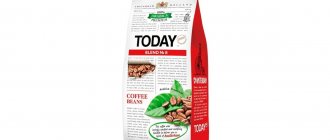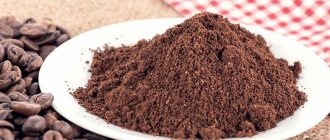The study revealed that over the past decade, the Russian coffee market has been developing dynamically.
From 2011 to 2020, the annual growth of the coffee market was 57.6% in volume terms. The growth of these indicators was facilitated by the active development of retail chains, an increase in retail space, as well as the development of new retail formats (coffee shops, vending machines, online stores, office coffee service).
The intensive growth of the coffee market confirms the increase in the amount of coffee consumed per capita in Russia over a ten-year period. If in 2001 this figure was 400 grams. coffee per Russian per year, then in 2020 in Russia there were 1.35 grams of coffee per year per person. However, Russia is an order of magnitude behind developed European countries in this indicator, where it ranges from 6.2 to 12 kg.
In 2001, 85.1% of consumers bought instant coffee, and in 2015 only 59% - demand for instant coffee fell by 26.1% and continues to weaken. Due to this, the demand for bean and ground coffee has increased, which has been growing for more than 10 years and will continue to grow for another 15 years until it approaches the average coffee consumption in Europe.
8% of customers take coffee to go when going for a walk or while on the road.
In September 2020, world prices for Arabica beans fell below a dollar per pound for the first time in 12 years, and for Robusta beans to $1,540 per ton. This data is provided by the Intercotinental Exchange, predicting an increase in coffee consumption and the popularization of new formats in Russia in the coming years.
World coffee market
Of the few most advanced variations of beans (Coffea arabica and Coffea canephora Pierre ex Froehn), about 70% Arabica and 30% Robusta are created on the world stage. A few more percent are allocated to exclusive varieties and mixtures inaccessible to the average person.
Many countries are engaged in the production and processing of grains. Now there are about 65 of them. Brazil can be considered the main supplier at present, as before. Its part accounts for about 40% of global flows. There are about 4 million fruit-bearing trees in this country, and up to 57% of the country's total harvest can be harvested on 51 hectares.
Coffee production in the world
Two industrial coffee species (Coffea arabica and Coffea canephora Pierre ex Froehn) account for about 98% of all coffee produced. From these, Arabica (70%) and Robusta (30%) . About 1-2% of coffee are rare, expensive varieties.
Today coffee is grown in 65 countries around the world . Depending on the crop, Brazil accounts for between 32 and 35% of the world's coffee production . There are approximately 4 million coffee trees in the country, which occupy 8.5 million km2. Small holdings of up to 50 hectares account for 56% of all coffee plantations and produce 75% of the coffee harvested.
Types of coffee: Arabica and Robusta
Arabica is considered a fine coffee : it has a richer and more intense taste than robusta. At the same time, it is much more difficult to cultivate : it is more susceptible to pests.
Arabica grows at an altitude of about 2000 meters above sea level. Ecuadorian plantations are considered the highest in the world. There, coffee grows at an altitude of 2000-2800 meters above sea level.
Robusta grows at an altitude of 0-600 meters above sea level in the tropical regions of Africa, India, Indonesia and is not at all whimsical. It contains orders of magnitude more caffeine than Arabica and is often used in espresso blends. Robusta is cheaper than Arabica.
When preparing 1 kilogram of roasted coffee, 4-5 thousand coffee beans are used. And about 1-1.5 thousand grains are collected from one tree per year.
Varieties of grains on the world stage: Arabica and Robusta
Arabica is preferable to Robusta; it is famous for its exceptional sophistication, which is why this type is very popular among the inhabitants of our planet. Arabica trees are very capricious, they require special care and climate: they feel good only in the highlands, they are more susceptible to diseases, and they are often attacked by pests. The optimal altitude for growing Arabica is 2000-2200 meters above sea level. Ecuador is considered the highest mountainous region for growing Arabica. There, fruit trees grow at an altitude of 2700-2900 m, and the grains are known for their good quality and exquisite taste.
Robusta is not so demanding to grow; this variety can grow well at an altitude of up to 700 m. The main suppliers of robusta can be considered India, Africa and other tropical regions of our planet. Robusta is more complex than Arabica in its composition: it contains more caffeine, and therefore, it is more often used to prepare strong drinks and mixtures. This variety is distinguished by its low price.
To get 1 kilogram of fried and ready-to-eat product, about 4.5 thousand fresh grains are used. Moreover, one plant in Brazil produces about 2 thousand grains per year.
Importing countries
The main suppliers of coffee in the Russian Federation are the following countries:
- Colombia;
- Argentina;
- Brazil;
- Ethiopia;
- Ecuador;
- Türkiye;
- Belgium;
- Italy;
- Vietnam and others.
Such popular brands of coffee are imported as:
- Jacobs;
- Nescafe;
- Paulig;
- Nespresso;
- Ambassador;
- Carte Noire, etc.
Coffee market in Russia
At the moment, the coffee market in Russia is not yet fully formed. The economic and, consequently, the trade crisis of the 90s is still alive in memory. Then not only Russia found itself in a difficult economic situation, but prices all over the world also increased, including for grains and their processed products. Conducting this type of business was also caused by a whole range of problems in technical equipment and delivery to customers.
Today we see increased purchasing power. The delicacy has become popular and accessible to all segments of the population.
Back in 2020, the Russian Federation signed an agreement with the famous International Coffee Organization (IOC). This pushed manufacturers to improve the quality of finished raw materials, and also resulted in a reduction in the costs of importing and packaging them. This economic event gave impetus to the merger of Russian trade turnover with global trade.
What determines the amount of duties on coffee?
As you might have guessed by studying the HS codes, a lot depends on the type, variety, form of release, even the size of the package. For example, coffee beans without heat treatment are transported on much more favorable terms than roasted coffee.
The cost of coffee also has an impact, since this is what is taken as the basis when calculating the duty. You should not indicate suspiciously low prices in invoices and declarations: this may arouse suspicion.
In addition, duty relaxations may apply in Russia. For example, they may cancel duties on the import of coffee from undeveloped countries. Before paying duties, check the current rates and customs clearance conditions. Duties may vary from year to year, and if you do not pay extra before clearing customs, your shipment may be delayed for some time.
Worldwide requests and offers
As of 2020, the market structure has changed dramatically. If you look back at 2001, you will notice the following trends:
- Compared to 2001, in 2020 the demand for instant products decreased. This is explained by rising wages among Russians, as well as effective advertising and the proven benefits of grain. If in 2001 a survey showed that 86% of respondents prefer instant drinks, while the same figure has now dropped to 49% and continues to decline.
- In 2020, the approximate consumption of this delicacy in Russia was 250,000 tons, and it also continues to rise.
- There are about 2 kilograms of these products per year per citizen.
- The record holders for drinking are citizens of Finland and Denmark, where the consumption of the drink per year per person is 12 kilograms! This figure in Europe is slightly less - only 8 kg per person, which is also much more than in Russia.
- Russian grain lovers are also divided into two groups: 37% of Russians buy grain, and the rest buy already ground grains.
- Since the coffee market in Russia is only growing, our citizens have become better aware of the varieties of beans, as well as the countries that produce them.
- A survey conducted in 2020 in Moscow showed that: 90% prefer the drink for breakfast, 45% during the day, in the evening the figure drops to 20%, and at night 3-5% of respondents drink this product.
- According to the same survey, Muscovites prefer to prepare the drink at home (95%), some drink the drink at work (45%), the rest buy a treat in a cafe (20%), another small group prefers to treat their guests (19%). At the same time, a considerable part of people take a glass with them when they go for a walk (10%).
Coffee retail trends: types, prospects, advantages
As explained by the head of the Roschaykofe Association, Ramaz Chanturia, since 2016, consumers have consistently abandoned instant drinks in favor of grain drinks. Over the past 10 years, the share of instant coffee in the Russian market has fallen from 82 to 60%. This is due to the arrival in Russia of a large number of coffee shops and the availability of home appliances for preparing a hot drink.
If we talk about the taste preferences of Russians, then, according to the research agency Magram Market Research, the leaders are:
- cappuccino – 43%;
- latte – 26%;
- Americano – 13%;
- raf – 4%.
Internet and dropshipping
The active development of online commerce has also boosted the coffee market. Today, online consumers are interested in both packaged beans and ground coffee, as well as instant coffee, but the choice is often made in favor of rare varieties and original packaging - something that is not always possible to find in retail.
Of particular interest to online visitors, according to RBC experts, are Internet sites with their own production facilities for roasting and grinding coffee beans. In this case, customers receive the freshest possible product. But no more than 200 companies are engaged in online sales of freshly roasted coffee in Russia. They supply most of their products to public catering; a smaller part is bought up by website visitors. Competition for individual roasters comes from caffeine chains that launch their own Internet projects.
Infographics based on the example of one of the popular sites selling freshly roasted coffee, Torrefacto (source - RBC).
The winners are those online stores that are ready to offer:
- maximum number of varieties;
- Possibility of choosing grinding – from the finest for cooking in a Turk to coarse for a French press;
- various packaging options;
- convenient payment methods;
- fast delivery of coffee to the office or home.
It doesn’t matter to buyers whether an online store sells its own products independently or works through a dropshipping system, making direct deliveries without warehouse storage and acting as an intermediary between the manufacturer and the consumer. But dropshipping is of interest to investors who are choosing the optimal business model for a future project.
Coffee to go
If in 2020 the boom in “coffee to go” captured megacities, then in the next two years the fashion spread throughout Russia. According to Magram Market Research, 57% of Russians always grab a glass of hot drink on the way to work or school, while the average age of buyers is from 24 to 44 years.
Magram Market Research analysts assessed the regularity of purchases as follows:
- 22% of respondents treat themselves to their favorite drink every day;
- 48% – make a purchase once or twice a week;
- 57% – could not name the exact number of times, but noted that they buy coffee on the go “from time to time.”
The majority of respondents drink coffee on the way (67%), the rest - already in the office or university classroom.
Vending (coffee machines)
Associate Professor of the Department of Trade Policy at the Russian Economic University Elena Mayorova is convinced that the weak saturation of the vending machine segment provides good potential for growth. This will lead to the trend of popularization of vending continuing in the coming years.
Experts from the National Automated Vending Association note that coffee machines generate 25-50% more revenue than others. But so far in Russia, vending accounts for only one percent of retail sales, although the comfortable global average is five percent. We have 100 thousand people per machine, whereas in Japan there is one machine per 20 people.
Experts predict an annual increase of 20% in automated retail over the next 5 years, because all the prerequisites are present. People like to “communicate with gadgets”, vending machines are becoming more accessible for investment, and since the summer of 2020, legislative amendments have been made on the use of cash registers in the vending business.
Coffee shops
In the last two years, the strongest competition for traditional coffee shops with seating has begun to come from coffee bars, where you can quickly buy coffee to go or drink it at the bar. While the former are used for business negotiations, dates, and meetings with friends, the active development of the Coffee to Go format spurs the rapidly accelerating pace of life.
A sign of 2020 was the launch of Specialty coffee shops, offering products in the highest price category. And this, according to the owner of the successful coffee bar chain Coffee Way, Sergei Buntsevich, is due to the fact that consumer tastes have grown significantly and many have stopped ordering “expresso” instead of “espresso”.
But coffee shops “on wheels” are still losing out to the usual formats. Buyers prefer to sit in the cozy chairs of stationary coffee shops or buy coffee to go.
Among the main reasons for the unpopularity of mobile coffee shops, experts cite strong competition from traditional retail outlets, difficulties with the legislative status of mobile “stalls” and buyers’ distrust of sanitary conditions. The mobile format is successful today only during periods of large city holidays or festivals, as well as as an integral part of catering.
Islands, tea and coffee shops
According to the Romir research holding, coffee sales in Russian supermarkets and specialty stores have decreased slightly since the beginning of 2020 - by 0.5%. At the same time, those who decided not to give up their favorite drink, on average, doubled each of their purchases.
According to Magram Market Research, every sixth supermarket visitor prefers to buy a glass of hot coffee at the “islands”.
Coffee machines and coffee makers at home and in the office
One of the trends in recent years has been the growing demand for home coffee machines and coffee makers, stimulated by the fashion for good coffee. According to the largest brands of household appliances, in the 1st half of 2020, sales volumes increased to 450 thousand units for a total amount of almost 5 billion rubles.
Along with capsules, grain and ground coffee are popular for preparing at home. But if before 2020, consumer preferences for instant and natural coffee were recorded as a ratio of 80 to 20, then by 2020 the priorities have shifted - 65 to 35. According to the executive director of the Rusprodsoyuz association, Dmitry Vostrikov, Russians have finally “tasted the taste of real coffee” , therefore they are not ready to give it up even with a reduction in income.
It's not just the home coffee culture that's growing. A drink prepared in a coffee machine has become part of business etiquette. Today, every self-respecting office has household coffee machines, and neither meetings nor business negotiations take place without a hot drink.
RBC experts, based on franchisees of one of the market leaders, calculated that launching a takeaway coffee outlet will cost 0.3-1.3 million rubles (the size of the investment depends on the location). Payback period is from 8 to 21 months. But along with a successful choice of location and format, it is more important to determine the audience and their preferences.
Who is the consumer?
It’s quite easy to depict the face of a modern gourmet:
- The aromatic delicacy is mainly consumed by residents of large cities with a fast pace of life (73% of all consumers).
- Mostly working people drink this invigorating treat; work often involves long-term mental or physical stress, which requires additional energy.
- The main consumers are people aged 20 to 50 years, students in higher educational institutions, those with an academic title and an average level of income.
- The interest of experts was aroused by the fact that the majority of consumers buy their favorite brand (35% of respondents); it is very difficult to convince them. Another part can choose from 3-4 brands; a very small share is occupied by people who often try new varieties (7%).
Structure of the Russian market
The entire coffee market in Russia is divided into several sectors, which are represented not only by quality criteria, but also by pricing policy:
- Natural (beans, ground);
- Soluble (in granules, powder);
- Decoupages and mixtures.
Back in 2005, there was an increase in the consumption of this delicacy by Russians. At that time, the digital value of trade turnover was about 6%. At the moment, the rate of consumption of this delicacy has increased even more and remains at around 300 conventional cups per person per year.
In Russia, the growth in the production of instant drinks, as well as their packaging within the country, is predominant. The main suppliers of grains are Brazil, Finland, India, Colombia and others. They do most of the packaging; Russia does about 50% of the packaging work, but this figure is growing every year. The most popular among Russians is still grain, its share in the Russian arena is ¾. By 2020, the export of Russian roasted beans to the CIS countries will prevail.
As for domestic consumption of the delicacy, the coffee market in Russia is still consistently divided into two equal parts between ground and instant. A small part is occupied by mixtures, since they have not yet been adapted to arouse interest among citizens.
Review of the Russian coffee market - 2020
Along with tea, coffee is a favorite drink of Russians, as well as one of the basic products of the consumer basket. The coffee market has remained among the most consistently growing for many years.
In 2011–2016, coffee increased its structural share in retail turnover. This was primarily due to the spread of fashion for visiting coffee shops and buying coffee to go, which, in turn, led to an increase in home consumption. The advertising activity of coffee and coffee equipment manufacturers also played a significant role.
According to estimates from Lavazza Marketing Director in Eastern Europe, Marco Barbieri, the volume of the Russian coffee market as of March 2019 was 2.2 billion euros, with 79% (1.8 billion) coming from retail sales, 13% (300 million) from for the catering sector, and 9% (100 million) for vending.
According to Nielsen RMS, in monetary terms, 70% of sales in the category come from the largest manufacturers: Nestle SA, Jacobs Douwe Egberts, Orimi Trade Group, Strauss Group and Food Empire Holdings.
Since coffee is not grown in Russia, the market depends on the global market and its trends: climatic conditions of supplying countries, changes in exchange rates and other factors.
According to the Federal Customs Service, coffee imports in physical terms are growing year on year, while decreasing in value terms (Table 1)
. The increase in 2020 compared to 2017 was 3%, and in 2019 compared to 2018 – 2.2%. In monetary terms, the volume of imports decreased in 2020 by 7.7% compared to 2020, and in 2020 by 2.8% compared to 2019.
The volume of coffee supplies to the Russian Federation is also growing in volume terms and decreasing in value terms. Every year since 2020, the volume of exports in physical terms has increased by 2%. In monetary terms, the difference between 2017 and 2020 was minimal, and in 2020 the volume of exports decreased by 7.7% (Table 2)
. At the same time, over the past years, the volume of coffee exports in physical terms has consistently amounted to about 3.5% of imports.
The main import item is non-roasted caffeinated and decaffeinated coffee - in 2020, 170,926.6 tons of goods in this category were imported, while roasted caffeinated and decaffeinated coffee - only 28,828.7 tons. In export goods, the situation is the opposite: the main item here is roasted coffee with and without caffeine. In 2019, supplies of these products amounted to 6,499.6 tons, while in the category of non-roasted coffee with caffeine and decaffeinated – only 389.3 tons.
In addition, import-export categories include coffee husks, coffee bean shells, as well as substitutes containing coffee in any proportion. In 2020, 213.9 tons of goods in these categories were imported, which in value terms amounted to $321.2 thousand. Exports of goods in this category amounted to 1.8 tons worth $18.9 thousand.
According to the Federal Customs Service, the main supplier of coffee to Russia is traditionally Vietnam, from where over 82 thousand tons of products were imported in 2020 (Table 3)
. In second place is Brazil with 41,939.7 tons. The third leading country in coffee supplies to our country in 2019 was Italy: imports from this country amounted to 14,238.9 tons. It can be noted that the cost of coffee imported from Brazil and Italy differs by more than 3 times, as evidenced by the ratio of imports from these countries in value and volume terms. This is due to the structure of imports: only roasted coffee is supplied from Italy, and mainly unroasted coffee is supplied from Brazil.
According to Rosstat, in 2020, production in the category of coffee substitutes, extracts, essences and coffee concentrates or coffee substitutes, as well as coffee husks and coffee bean shells continued to grow in physical terms.
At the same time, the production of roasted coffee, which showed almost double growth between January and November 2020, decreased by a third in 2020 compared to the same period in 2018.
Based on the general production indicators in the category “decaffeinated coffee and roasted coffee,” we can calculate that the production of decaffeinated coffee showed the opposite trend: in January–November 2020 it increased significantly compared to the corresponding period in 2018 (Table 4)
.
The structure of consumption of different types of coffee gradually changed: instant coffee gave way to roasted/ground coffee. According to the Roschaykofe association, at the beginning of 2020, 51% of the market was occupied by roasted coffee, and 49% by instant coffee. In 2001, the market was formed by 31% of roasted coffee and 69% of instant coffee.
In value terms, finished products in the tea and coffee production category have shown stable growth since 2020. According to Rosstat for the period from January to September of the corresponding year, in 2020 products worth 5,353,072 thousand rubles were produced, in 2020 - 5,864,269 thousand rubles, in 2020 - 7,468,397 thousand rubles.
One can note an increase in average producer prices for extracts, essences and concentrates of coffee or coffee substitutes based on data for November 2017–2019. Thus, if in the period under review, 2020 and 2018, average producer prices were, respectively, 371,909.66 and 385,621.27 rubles, then in the same period of 2019 they increased to 440,568.96 rubles per ton.
Analyzing Rosstat data, one can notice an increase in retail prices both for coffee in terms of kilograms and for coffee in fast food organizations in terms of 200 grams (Table 5)
.
According to AC Nielsen, the Russian capsule coffee market demonstrates significant positive dynamics: its annual growth is 20 and 18%, respectively, in monetary and physical terms. At the same time, the share of capsule sales is at the level of 1% of the total coffee sales in Russia.
As for coffee shops, according to the Nielsen study “Entertainment and Eating Out Consumers”*, visiting public catering establishments is an important way of spending leisure time for Russians. Thus, 99% of study participants visit cafes and coffee shops, fast food establishments and self-service cafes. If they refuse to visit, it is primarily due to increased prices (62% of respondents answered this way), as well as due to social factors (no company, reason or free space - 52% of respondents). Thus, the take-away coffee market is growing, as well as the format of coffee shops where you can quickly and inexpensively have a snack.
As Business Planner analysts note, the number of classic-format coffee shops is declining, new players in this format are not entering the market, and over the past few years, new successful federal chains have been formed in the format of single-coffee shops and “coffee to go.”
*The third wave of the syndicated Entertainment and Eating Out Consumer Study was conducted in November 2020 through an online survey of 1,200 entertainment and eating out consumers. The sample reflects the gender and age structure of the online population in Russia.
Article for Russian Food magazine No. 1-2020
Share with friends
- 4
Soluble products
In 2020, the demand for grain products has sharply increased; decent establishments offering quality treats are opening in small towns. Due to this, the demand for instant drinks has decreased. However, grain products still have a high price, so not everyone can afford it.
The product in granules remains predominant, followed by crystalline and powder, the benefits of which are quite questionable. Meanwhile, the demand for high-value products is growing. Manufacturers approached the issue competently; the composition of the soluble product must meet not only the requirements of customers, but also our standards.
Cereal products
During the 2020 crisis, a small proportion of citizens changed the brand to a cheaper one of the same bean coffee. This is explained by the fact that Russia has jumped into the era of quality products, because now everyone knows that whole grains are healthier.
The share of domestic trade turnover accounts for 66% of natural coffee produced by Russian companies. Among them:
- "Orimi Trade"
- "Moscow coffee shop on shares"
- Tea and coffee shop
Foreign firms such as Paulig are also present. This Finnish company recently opened a bean roasting plant in the Tver region. The income of this company can be considered one of the largest.
Transportation Features
Coffee quickly absorbs extraneous odors and moisture, so it is advisable to transport it separately from other goods, or take this point into account when forming a shipment for transportation, and also maintain air humidity of no more than 7%. Transportation is carried out in plywood boxes, with paper or parchment. Coffee can be transported by any means of transport, but it is important that the vehicle is clean and dry. Boxes of coffee are placed in a row. Coffee beans can be transported in bags. Instant and ground coffee are often shipped in plywood boxes or containers.
How do Russians choose coffee?
Our compatriots have established a certain plan according to which the majority chooses their drink. Among them are the main criteria:
- In terms of quality (nowadays many people know what high-quality grains should look like);
- Popularity of the brand;
- Country of origin (more often the choice falls on Brazil and Italy);
- Competent advertising policy;
- High-quality packaging;
- Price category.
Quality comes first for our citizens. This explains the weak transition to cheaper brands, even during the crisis. In order to save money, people simply buy their favorite brand in smaller quantities.
Soluble is in demand only in the case of a competent advertising campaign.
Selling coffee
The distribution of products among retail outlets and centers has its own characteristics. The number of hypermarkets, regular stores and Cash&Carry is growing every day. Depending on what needs to be sold, the appropriate point of sale is selected. So, if you need to sell loose or bagged tea, then the importance of trading channels is much higher for the first option.
The situation with coffee is different; grain coffee is in greater need of popularization, while instant coffee can be purchased even in a simple food stall. If you need to buy decoupage, it will be easier to find it in small branded stores or specialized markets.
When considering instant products, the analysis shows that their share in interstate channels is 36%, while grain occupies about 50%, and decoupages - only 17%.
It is difficult to replace coffee and tea with other drinks. Therefore, even in conditions of a severe crisis, their value remains unchanged. Under the most difficult circumstances, people will switch to cheaper types, but not abandon them.
Coffee certification
Certification of coffee is carried out based on the requirements of the Russian Federation TR. To smoothly cross the customs border, the foreign trade participant must have the entire package of documentation that will confirm the quality and safety of the cargo. Coffee and drinks made from these products in the Russian Federation are controlled by GOSTs.
Coffee must comply with the standards of the CU TR “On Food Safety”. The owner of the cargo must make a single declaration of conformity for the goods. When the document is received, the coffee is marked with the EAEU sign.
Coffee certification services are carried out by professionals from the Standard Line customs representative, who work with all types of shipping documentation and prepare it in accordance with all TR rules.
Certification services include the collection of documentation, selection of the type of shipping documentation in accordance with the HS code of the cargo and assistance in laboratory tests.
Need to know! A sanitary certificate is required for customs clearance of coffee. It can be issued after the state. registration of goods in Rospotrebnadzor.
If you have any questions, call our specialists at number.
Russian import
Oddly enough, coffee is one of the most imported goods. This is all due to the fact that Russia does not have the necessary climatic conditions for growing trees. Domestic producers only process and roast imported grains. Most supplies to Russia come from three countries: Brazil, Vietnam and Italy. Other supplies are less significant and there is no special demand for them.
It is safer to transport grains in a raw state, as they retain their beneficial properties longer. Therefore, imports of fresh fruits account for half of the total imported product. According to experts, the next couple of years will see an increase in imports for industrial processing. This is due to the dynamic development of domestic roasting technologies. Another reason is the increased demand for fresh grains among Russians - an increase of 5% will be observed in the next three years.
During this time, imports of ready-to-drink coffee will remain at their level of 50% of the total. This is due to the increased interest of our citizens in the new delicacy.
Export to Russia
Russian companies have been exporting finished products to European countries and the CIS for a long time. Foreign companies are interested in:
- Naturally roasted product with caffeine (about 75% in granulated and ground form);
- Arabica (23%);
The main exporting countries are the former Soviet republics - Belarus, Abkhazia and others. Until recently, the largest consumer of Russian products was Ukraine (69% of exports), but due to difficult political relations this percentage has decreased significantly.
In Russia, the most important exporters are two capitals - Moscow and the region (45%), St. Petersburg and the region (40%). About 52 domestic companies operate in this specialization. But only 4 of them are large and take up about 85% of all processing.
Classification code of the Commodity Nomenclature of Foreign Economic Activity and customs payments
Coffee and coffee drinks belong to product group 09... The remaining digits of the code depend on the type of coffee, packaging, variety and other parameters: ground or grain, caffeinated or decaffeinated, Arabica, Robusta or other. In particular, unroasted coffee is declared under code 09011..., roasted coffee - 09012... An unroasted product is not subject to import duty, only VAT is paid - 20%. And for the import of roasted coffee, in addition to VAT, a duty of 8% of the customs value is charged, but not less than 0.16 euros/kg.
In addition, coffee extracts, such as instant freeze-dried coffee, are declared under code 2101. This is not a coffee substitute containing coffee, classification code 0901909000 (5% duty). Instant freeze-dried coffee in the Commodity Code of Foreign Economic Activity has the code 2101 11 001 5 or 2101 11 001 6, the duty rate is 7.5%, but not less than 0.34 euros/kg. The duty may be waived if the coffee is imported from a developing economy.
Note! Duties and taxes are charged only to legal entities. Individuals who import coffee for their own needs in quantities not exceeding the norm for personal consumption pay nothing.
Taking into account the fact that the duty is calculated based on the customs value indicated in the declaration, there is a great temptation to artificially reduce the cost. This should not be done, since too low a price arouses suspicion and increased attention from customs services. They may require documents, such as checks, confirming the specified amount.
Leading manufacturers
The leaders of the coffee market in Russia can be divided into several groups according to various classifications.
- For companies with a controlling stake:
- Domestic (("Orimi Trade", "Moscow coffee shop on shares", LLC "Tea and Coffee", Strauss Group)
- Wide range of products (Nestle Russia, Mondelez, Orimi-Trade).
- By type of product:
- Beans (Paulig)
- Mixed (Nestle Russia, Tchibo, Strauss Group, Orimi-Trade, Moscow Coffee House on Shares)
- Granular (Mondelez).
- By quantity produced
- Less than 2500 tons/year (Nestle Russia, Mondelez, Tchibo, Paulig, Orimi-Trade, Strauss Group
- From 700 to 3200 tons/year (“Moscow coffee shop on shares”, “Russian product”);
- More than 700 tons/year (“Montana Coffee”, “Safari Coffee”, etc.).
More than half of the instant product is created by three main companies: Nescafe Russia, Mondelez and Tchibo. Nescafe can be called a leader, since the company produces half of all products.
If we talk about grain, about 70% is produced by Russian companies listed above in the lists. The foreign company Paulig Group remains in fourth place. Let's take a closer look at the largest companies.
Nestle Russia:
The first time we heard about this company was 22 years ago. It was opened in Moscow and almost immediately occupied most of the market. Now her main task has become to strengthen sales, since the company is sufficiently advertised in Russia. Production is in full swing. This company occupies a large part of the domestic coffee market in all its segments.
Mondelez
The holding is a year older than the previous one; it used to be called Kraft Foods Russia. Has the same production.
Tchibo
The very first company on the Russian market appeared 24 years ago. Its main task is to expand its sphere of influence and active sales.
"Moscow coffee shop on shares"
opened in 1997. The first plant was launched in Eastern Europe in 2004-2005. The products are also extensive, presented in various variations on the domestic and world markets.
Development forecast: coffee market in Russia for 2020
In Russia, the consumption of bean coffee continues to gain momentum. Its share in our market is growing. Manufacturers guarantee higher quality of the product, thanks to the already well-known economic union with the International Coffee Organization. The global coffee market is showing positively stable growth. An invigorating treat is one of the most popular products for everyday use at home.
Currently, cereal and instant product consumption is the same. However, it is expected that by 2020 the consumption of grains will increase, due to their naturalness and proper marketing. This can also be associated with the growing culture of drinking the drink, the emergence of various toppings and syrups, as well as mixtures and decoupages, which are only gaining popularity. Since cheaper varieties are used in the production of granulated beans, which are imported into our country in smaller volumes, we can say that in 2018 imports of robusta will be even less compared to the exquisite Arabica variety.
In Russia, coffee is treated with great reverence, and it is unlikely that anyone will deny themselves the pleasure of drinking a cup of aromatic delicacy, which will only increase the purchasing power of citizens.
Documentation
Transportation and commercial documents are prepared for customs clearance. These include:
- foreign economic contract;
- invoice or invoice;
- transport documents (for example, air waybill, bill of lading, etc.);
- documents describing the nature of the cargo and its properties (in the case of coffee, information about the variety, degree of processing of the beans, and packaging must be present);
- transaction passport;
- sanitary certificate;
- certificate (declaration) of conformity.
The last document in the list is drawn up in advance and confirms compliance with state standards, namely TR CU “On Food Safety”. The product for which the certificate has been received is marked with the EAEU sign. A sanitary certificate is issued after registration with Rospotrebnadzor.
Errors in documents, as well as corrections, blots, inaccuracies, and inconsistencies in the description of the cargo are unacceptable. The absence of any document or insufficient information leads to increased attention from customs officers: a thorough inspection of the cargo, examination. Serious problems can also arise if the wrong classification code is assigned, because it determines the amount of duty charged. Even though coffee is not a perishable commodity, it has a certain shelf life. Due to errors, processing delays are possible, in exceptional cases very long. Therefore, it is so important to provide for all the nuances and prepare properly.











